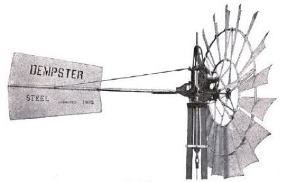Last updated: August 3, 2019
Article
Dempster Steel Windmills

NPS/Dempster Archive
Dempster Steel Windmills
Dempster steel windmills refers to open back-geared steel windmills. Back-gears and curved blades allowed these metal mills to out-pump older wooden mills. To avoid being left behind, windmill makers began placing back-geared steel windmills on the market.
Dempster Steel windmills were designed with their wheel mounted slight to one side so they turned away from increasing winds. Most of the mills were equipped with coiled governor springs to pull the wheel back to face the wind when the wind slowed down. This gave the mill a more-or-less steady rate of operation.
Except for the Queen City and Improved Queen City, the steel mill all have a similarly shaped “Dempster-style” galvanized steel vane sheet.
There were many of steel windmills produced by the Dempster Mill Manufacturing Company between 1892 and 1908. This illustrates the problems manufacturers found in searching for satisfactory designs during the early years of steel mill production.
Queen City (1892-1897)
Placed on the market 1892, the Queen City became the first all-steel Dempster product. Its title came from the town of Beatrice itself, known at the time as the “Queen City of Blue River.” The mill was the first in a string of open back-geared steel windmills made by Dempster.
The Queen City windmill, was only made in an 8-foot diameter. Customers could order the steel parts either painted or galvanized. Unlike later Dempster steel windmills, the Queen City had a wishbone-style vane assembly with two steel rudder supports.
Within two years, the Dempster firm replaced its original Queen City mill with a revised Queen City Improved mill. Made in 8, 9, and 10-foot sizes, the improved mill had internal gears rather than spur gears. Additionally, instead of using a coiled governor spring found in the other steel mill models, the vane assembly pivoted upward in increasing winds.
Dempster Steel (1896-1909)
The Dempster Steel 1896 and 1897 Pattern was introduced in 1896 in 8 and 10-foot sizes. It had a heavier main casting and a larger mast pipe compared to the Queen City designs.
The Dempster Steel 1897 and 1898 Pattern was introduced in 1897. It had the same basic design of the earlier 1896-97 style. The main difference was that the iron parts were built stronger for the extreme wind conditions of the Great Plains. This pattern was made in 9 and 10-foot sizes.
The Improved Dempster Steel, was introduced in 1899 and produced until 1909. This mill was made in 6, 8, 10, and 12-foot sizes. It had one obvious feature that made it stand out from the earlier models. This was a prominent inverted U-shaped guide rod that fastened to the main casting at two points.
Dempster No. 6 (1903-1906)
The next open back-geared steel mill to emerge was the Dempster No. 6 in 1903. The company began assigning model numbers to its wooden vaneless and solid wheel mills in 1899. This was the first all-metal mill to receive a number.
The Dempster No. 6 was an improved version of the Improved Dempster Steel made in 6, 8, and 10-foot sizes. It employed the same inverted U-shaped guide rods. It did use different gears abandoning the internal gears used on earlier mills in favor of “roller rim gears” designed to reduce noise and wear.
Dempster No. 7 (1904-1922)
The Dempster No. 6 was not on the market long with the introduction of the Dempster No. 7 in 1904. Made in 6, 8, 10, and 12-foot diameters, this mill was similar to the No. 6. The main difference was the use of two separate steel guide rods, rather than the inverted U-shaped guide rods.
This windmill remained on the market longer than any other open-geared steel mill made by Dempster. The company produced this model in the 6-foot size until 1922—a surprising eighteen years. As other windmills came and when, the little 6-foot No. 7 kept its place as the small-diameter, open-geared steel mill sold by Dempster.
Arrow Steel (1906-1908)
In 1906, Dempster introduced the short-lived Arrow Steel model. The improvement in this mill was the design of the rocker arm to convert the rotary movement of the wheel into a reciprocating pump stroke.
Dempster No. 8 (1908-1917)
The company placed another back-geared steel mill on the market in 1908. The Dempster No. 8, represented refinements to the design of the Arrow Steel. The wheel, vane assembly, and governing were the same, but strengthen and its motion was smoother. This mill was made in 6, 8, 10, and 12-foot sizes.
Dempster No. 10 (1915-1925)
The Dempster No. 10 was a “twin gear’ mill. The No. 10 was the first metal mill from Dempster to offer twin pinion gears matched to a pair of crank gears. It appeared in 8, 10, and 12-foot sizes taking the place of the No. 8 mill.
The Dempster No. 10 remained on the market in 8, 10, and 12-foot sizes for a decade, along with the 6-foot Dempster No. 7. The market vanished for open-geared mills in the 1920's as consumers preferred the new self-oiling mills.
Sources
- Baker, T. Lindsay. 1984. A Field Guide to American Windmills. Norman, Oklahoma: University of Oklahoma Press. p. 184-185, 188-189.
- Baker, T. Lindsay. 2001. "Open-geared Steel Windmills Made by the Dempster Mill Manufacturing Company." Windmillers’ Gazette. XXVIII, No. 1 (Winter 2009) p. 4-9.
- National Park Service. Homestead National Monument of America. Dempster Mill Manufacturing Company Records, 1878-2010.
Prepared by Amy Neumann, 2019
